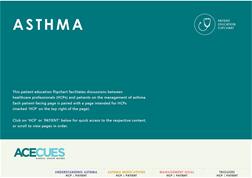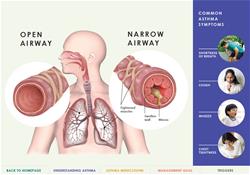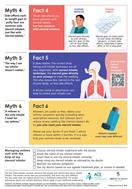Asthma – optimising long-term management with inhaled corticosteroid
Asthma is a chronic respiratory condition commonly seen in primary care. The management goal for asthma is to prevent or minimise symptoms and reduce risk of poor outcomes.
A significant shift in the approach to treating asthma has come about recently, which can help patients to be more symptom-free, and less likely to experience exacerbations, among other benefits. See the ACE Clinical Guidance (ACG) on asthma for more details.
The asthma resources listed below are in keeping with the ACE Clinical Guidance (ACG) on asthma to support asthma patient education and self-management.


This flipchart facilitates discussions between healthcare professionals and patients or caregivers on the management of asthma. Click here to download the resource.
A WAAP is a patient-specific set of instructions for managing asthma completed by the doctor or another suitably trained healthcare professional together with the patient (or caregiver).
Different WAAP templates exist. However, they should all include space for clear and individualised information on:
- The patient's usual asthma medications (preventer, reliever), including medication name, route, dose, and frequency
- Adjusting asthma medications when symptoms are worsening
- Recognising an asthma-related emergency and how to seek help
A WAAP should be kept in multiple places that are convenient and accessible (for example, at home, at the workplace, in the bag, or saved as a digital copy on mobile phone). As the patient’s asthma condition or medications may change over time, regular review of the WAAP between the healthcare professional and the patient (or caregiver) is important.
Click on the links below for selected WAAP templates (for healthcare professionals to choose, according to applicability to their patients and practice).
| Organisation |
Key features of WAAP template |
WAAP template |
Asthma and Respiratory
Foundation New Zealand |
- Includes pictorial instructions on how to use a spacer
- Ambulance number included is for New Zealand; emergency ambulance number to call in Singapore is 995
|
4-stage Asthma Action Plan
|
| Asthma UK* |
-
Details can be filled in electronically
-
Ambulance number included is for the United Kingdom; emergency ambulance number to call in Singapore is 995
|
Your asthma action plan
|
| Global Initiative for Asthma (GINA) |
-
Developed for use in any country, as part of an international strategy for asthma
|
Asthma Action Plan
Please refer to page 21 of the GINA Implementation Toolbox 2019
|
| National Asthma Council Australia |
-
Available in 2 languages (English and Chinese)
-
Ambulance number included is for Australia; emergency ambulance number to call in Singapore is 995
|
Asthma Action Plan

15 October 2020 © National Asthma Council Australia
|


Patients with asthma or their caregivers may have concerns about the prescribed treatment. This fact sheet may help answer some questions about the use of steroid inhalers. Download the resources below:
Attention:
It is good practice to review your inhaler technique as often as you can.
In addition to watching the selected video, please refer to the information leaflet that comes with your inhaler or spacer for instructions on:
- Priming (preparing your inhaler or spacer for the first use, or if it has not been used for some time)
- Cleaning
- Storage
- Expiry date

|
Accuhaler
Click here for video (Source: Asthma UK*)
Accuhalers registered in Singapore for asthma
Seretide Accuhaler, Ventolin Accuhaler
|
 |
Easyhaler
Click here for video (Source: Asthma UK*)
Easyhalers registered in Singapore for asthma
Beclomet Easyhaler, Buventol Easyhaler, Giona Easyhaler
|
 |
Ellipta
Click here for video (Source: Asthma UK*)
Elliptas registered in Singapore for asthma
Arnuity Ellipta, Relvar Ellipta
|

|
Forspiro
Click here for video (Source: Asthma UK*)
Note:
As you use the inhaler, the foil strip will become longer. Please tear it off when there are more than 3 sections (called “blisters” in the video) on the foil strip, otherwise the inhaler may get jammed.
Forspiro registered in Singapore for asthma
AirFluSal Forspiro
|

|
NEXThaler
Click here for video (Source: Asthma UK*)
NEXThaler registered in Singapore for asthma
Foster NEXThaler
|

|
pMDI
Click here for video (Source: Asthma UK*)
pMDIs registered in Singapore for asthma
Alvesco inhaler, Azmasol inhaler, Beclo-asma inhaler, Budiair inhaler, Clenil inhaler, Flixotide Evohaler, Flutiform inhaler, Foster inhaler, Salbuair inhaler, Salbutamol Sandoz inhaler, Seretide Evohaler, Symbicort Rapihaler, Ventolin Evohaler, Zenhale inhaler
|
 |
pMDI with spacer
There are 2 breathing techniques for using a pMDI with a spacer – tidal breathing, or single breath and hold. Please use the breathing technique advised by your healthcare professional:
(Source: Asthma UK*)
Note:
For tidal breathing technique, the number of breaths needed may differ between adults and children, and between spacer brands.
pMDIs registered in Singapore for asthma
Alvesco inhaler, Azmasol inhaler, Beclo-asma inhaler, Budiair inhaler, Clenil inhaler, Flixotide Evohaler, Flutiform inhaler, Foster inhaler, Salbuair inhaler, Salbutamol Sandoz inhaler, Seretide Evohaler, Symbicort Rapihaler, Ventolin Evohaler, Zenhale inhaler
|
 |
pMDI with spacer and face mask
There are 2 breathing techniques for using a pMDI with a spacer and face mask – tidal breathing, or single breath and hold. Please use the technique advised by your healthcare professional:
(Source: Asthma UK*)
Note:
For tidal breathing technique, the number of breaths needed may differ between adults and children, and between spacer brands.
pMDIs registered in Singapore for asthma
Alvesco inhaler, Azmasol inhaler, Beclo-asma inhaler, Budiair inhaler, Clenil inhaler, Flixotide Evohaler, Flutiform inhaler, Foster inhaler, Salbuair inhaler, Salbutamol Sandoz inhaler, Seretide Evohaler, Symbicort Rapihaler, Ventolin Evohaler, Zenhale inhaler
|

|
Turbuhaler (also known as Turbohaler)
Click here for video (Source: Asthma UK*)
Turbuhalers registered in Singapore for asthma
Pulmicort Turbuhaler, Symbicort Turbuhaler
|
* The charity Asthma UK is part of the Asthma UK and British Lung Foundation Partnership.
Statement of intent:
The information provided on this webpage and the linked webpages is to assist healthcare professionals and patients (persons with asthma) in managing/treating asthma. The information is not exhaustive of the subject matter and does not replace clinical judgement of or advice from a healthcare professional. The responsibility for exercising clinical judgement and making decisions appropriate to the circumstances of the individual patient remains at all times with the healthcare professional. Patients (or their caregivers) are advised to speak to their healthcare professionals for further information about their asthma treatment.
Disclaimer:
The Ministry of Health, Singapore disclaims any and all liability to any party for any direct, indirect, implied, punitive or other consequential damages arising directly or
indirectly from any use of this webpage and the linked webpages, which are provided as is, without warranties.